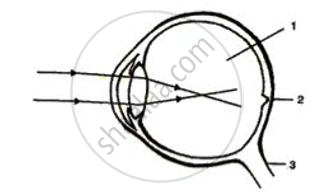Advertisements
Advertisements
प्रश्न
To read a book held at a distance of 25 cm, will she need converging or diverging spectacle lenses?
उत्तर
To read a book held at a distance of 25 cm, the person, who is long-sighted, will need converging lenses.
APPEARS IN
संबंधित प्रश्न
Write the importance of ciliary muscles in the human eye. Name the defect of vision that arises due to gradual weakening of the ciliary muscles. What types of lenses are required by the person suffering from this defect to see the objects clearly?
Akshay, sitting in the last row in his class, could not see clearly the words write on the blackboard. When the teacher noticed it, he announced if any student sitting in the front row could volunteer to exchange his seat with Akshay. Salman immediately agreed to exchange his seat with Akshay. He could now see the words written on the blackboard clearly. The teacher thought it fit to send the message to Akshay’s parents advising them to get his eyesight checked.
In the context of the above event, answer the following questions:-
(a) Which defect of vision is Akshay suffering from? Which type of lens is used to correct this defect?
(b) State the values displayed by the teacher and Salman.
(c) In your opinion, in what way can Akshay express his gratitude towards the teacher and Salman?
Which defect of vision can be rectified:
by using a concave lens?
A man can read the number of a distant but clearly but he finds difficulty in reading a book.
From which defect of the eye is he suffering?
A person suffering from the eye-defect myopia (short-sightedness) can see clearly only up to a distance of 2 metres. What is the nature and power of lens required to rectify this defect?
Though a woman can see the distant object clearly, she cannot see the nearby objects clearly. She is suffering from the defect of vision called:
(a) long-sight
(b) short-sight
(c) hind-sight
(d) mid-sight
The picture given here shows a person wearing 'half-moon' spectacles. What sort of eye-defect do do you think he has? Why are these particular spectacles useful to him?
Given alongside is a diagram depicting a defect of the human eye. Study the same and then answer the questions that follow:
(i) Identify the defect.
(ii) Name the parts labelled 1, 2 and 3.
(iii) Give labelled two possible reasons for this eye defect.
(iv) Draw a labelled diagram to show how the above mentioned defect is rectified.

A person is unable to see objects distinctly placed within 50 cm from his eyes.
(a) Name the defect of vision the person is suffering from and list its two possible causes.
(b) Draw a ray diagram to show the defect in the above case.
(c) Mention the type of lens used by him for the correction of the defect and calculate its power. Assume that the near point for the normal eye is 25 cm.
(d) Draw a labeled diagram for the correction of the defect in the above case.
Match the following:
| Column - I | Column - II |
| 1. Retina | a. Path way of light |
| 2. Pupil | b. Far point comes closer |
| 3. Ciliary muscles | c. near point moves away |
| 4. Myopia | d. Screen of the eye |
| 5. Hypermetropia | e. Power of accommodation |
Name the following:
Two kinds of accomodations.
